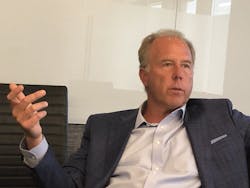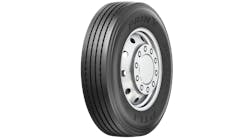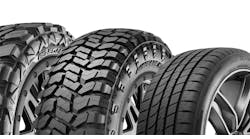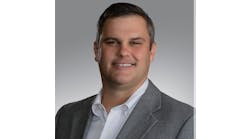Jeff Barna has seen a lot of changes since he was elevated to the top role at Yokohama Tire Corp. two years ago. And he’s driven quite a few changes of his own design, in an effort to position the company for future growth.
In this in-depth interview with MTD Editor Mike Manges, Barna reflects on Yokohama’s 2019, which he calls a year of “high intensity and organizational resilience” for the organization. He also discusses Yokohama’s efforts to accelerate its product development cycle, the company’s OE strategy, the importance of staying flexible in response to ongoing consolidation at the dealer level, the latest on Yokohama’s U.S.-based manufacturing plants, opportunities on the commercial tire side of the business and more.
Through it all, Yokohama’s network of independent dealers will continue to play a critical role in the company’s evolution, according to Barna. “The customer is looking to us for guidance,” he says.
MTD: Two months into the new year, can you provide an assessment of 2019? How did Yokohama Tire Corp. fare last year? What were your big challenges and how did you overcome them?
Barna: We dealt with a good deal of adversity, some of which was self-inflicted and some of which was market-related. We aligned with our distributor partners in the fourth quarter of 2018 as a strategy to hedge against potential SAP implementation implications. We found ourselves promoting stocking plans to help them in the event we had any supply disruptions, only to discover we ended up being flawless. So, it was a bit of a false alarm, but our dealers came into the new year of 2019 with high stocking levels in what we viewed was a soft market. In addition, we initiated a number of organizational initiatives. We did a reorganization of our sales group and brought in a new vice president of sales. We now have more of an administrative backbone, so to speak. We also had tariffs to contend with, specifically on the OTR side of our business. (Editor’s note: Yokohama sources some of its OTR tires from China.)
I think 2019 was important to us because, dare I say, 2017 and 2018 were almost too easy. There were a lot of opportunities to streamline functions and processes and get more aligned around our strategy to make sure we deployed our resources the right way. We now have more focus on what matters most. We leveraged customer relation management in terms of identifying high-impact opportunities, rather than just calling on anybody. We launched nine new products on the consumer replacement side, which was a tremendous undertaking – not only for our marketing department and sales team, but also our customers, as they transitioned to new treads and upgraded from existing treads. But we came through with flying colors. The products are phenomenal and the feedback we’ve received from our dealer community has been outstanding.
MTD: Four out of those nine products were part of your Advan product line. Why is Yokohama placing renewed emphasis on Advan?
Barna: I don’t want to suggest we had an identity crisis, but we seemed to be drifting into the (realm) of becoming market generalists. 2019 was the 50th anniversary of our business in the U.S. and it gave us an opportunity to reflect and reconnect with our roots. When Yokohama came to the U.S., our renown was for ultra-high performance, light truck, off-road, racing/motorsports -- those arenas. And over time, as some companies do, (we said) “We have such good momentum in (a particular) market. What if we had tires for the Camry or the Taurus?” All of a sudden, you begin to migrate toward trying to be everything to everyone. If you aren’t careful, it pushes you away from your true identity. 2019 gave us an opportunity to revisit the true purpose of our company and how we service the U.S. market.
In 2018/2019, we came out with three or four terrific light truck tire products that are doing great. And the backside of that product planning in 2019 and 2020 is a strong resurgence in high performance and ultra-high performance products. It’s really been the culmination of introspection and trying to get better. We will always be a broadline supplier because customers always will have that expectation. But we want our customers to view us as being at the leading edge.
MTD: During the 2019 Specialty Equipment Market Association Show, it was mentioned that Yokohama is accelerating its product development cycle. Why is it important to develop and introduce more tires, more quickly, and how does that play into your overall consumer tire product strategy?
Barna: It starts with self-awareness and transitioning away from being market generalists to a company that has a very strong identity in performance niches. We’ve had an opportunity to address gaps and significantly upgrade existing platforms. We’ve been preaching product vitality and gaining a clear picture of what new products relate to our revenue. Today, between 70% and 80% of our top and bottom lines are attributable to products that are five years old or younger.
We’re coming to a close on product development acceleration. Importance will now be placed on governance to ensure that our products don’t age out. We’ve developed a very intentional, generational plan for the products we’ve recently brought to market. We’ll have a nice, steady turn of two to three treads per year. That’s the rigor around how we define product vitality and how we’re pushing it to the marketplace. It also gives our salespeople new and exciting things to talk about and that’s never a bad thing.
MTD: What’s your take on the current North American consumer tire market? What important trends are you observing and how are they impacting Yokohama?
Barna: The market is still unsettled. We’re keenly aware of what can be on the horizon in terms of acquisitions, footprint rationalizations, etc. I have to make sure our team is aligned, and how we can be agile and adaptable but also still extremely focused on the expectations our parent company has.
One thing I’ve been fascinated with as of late is that it seems very in vogue for a lot of our competitors to speak about very advanced scientific developments that may or may not come true. They spend a lot of time talking about electric and automated vehicles, and the internet of things, and you can go down the line. The reality – and our responsibility as a manufacturer – is to make sure there is static focus on real-time, current developments in the marketplace. As our customers look at all of that noise, they know they have a supplier in Yokohama that helps them focus on supply, margin pressures and other things that directly affect them.
If you ask a dealer to tell you what keeps him up at night, he’s probably thinking about employee turnover and that competitor who opened a new warehouse in his backyard – those kinds of things. Does that mean that Yokohama will not be vested in autonomous vehicle or ride-sharing technology? That’s not what we’re saying. Those things, when they come to fruition, will be table stakes. We’re trying to keep everybody focused on what matters in the here and now.
MTD: Independent tire dealers have been a key driver of Yokohama’s success in the U.S. And Yokohama is well-represented among the nation’s largest dealers. What will your dealer mix look like going forward? Do you target a ratio between big regional dealers and smaller operations?
Barna: We have longstanding relationships with dealers who have grown with us. And we want to do everything we can to fortify that. The core of Yokohama Tire Corp. is (helping our dealers) sell to the end user.
MTD: What is Yokohama's OE strategy?
Barna: In one word, elevation. Carrying into 2020, we are looking at unprecedented growth in our OE positioning. We do realize that we haven’t always made it easier for our (dealer) channel customers, with respect to the amount of OE business we currently have versus what some of our competitors have. Our dealers are constantly asking us to get more OE business so they can capitalize on the pull for high-end products. But if you look at how we index with respect to our OE share versus our aftermarket share, we enjoy a high percentage of replacement share, in spite of a low ratio of OE fitments.
Fast forward to today, we’ve taken on substantial OE business that I think will create a tremendous amount of opportunity for our dealers and distributors. We have to be more deliberate than most in terms our production capabilities. It’s important to manage the right ratio. But if we feel we can create an environment that provides more demand, we’re going to give that OE fitment as very strong look.
MTD: Speaking of production, can you bring us up to speed on your consumer tire plant in Virginia and your truck tire plant in Mississippi?
Barna: Our plant in Virginia is highly stable and is one of those most, to my knowledge, reliable plants in the industry. Our customers like buying products from that plant. Everything there is highly stable. Through-put levels are at a three-year high. Service levels and fill rates are very good. Steady as she goes is the story at Virginia. Our plant in Mississippi has been a developing story. We are now starting to see our way to the best production rates in that plant’s history.
MTD: At what capacity is that plant running?
Barna: We’re running in the vicinity of 70%. We’re broadening the SKU production count there, which gives us an opportunity to provide a greater variety of products for our customers.
MTD: What opportunities do you see on the truck tire side of the business – not just traditional, long haul tires but also products for more specialized applications like pickup and delivery, last-mile and regional-haul?
Barna: A number of our new products are hitting pickup and delivery, last-mile – 19.5-inch tires, etc. In terms of the last-mile segment, I’ve been a personal champion of product development for the Sprinter van area. We’re a little behind there. But I think we have the opportunity to better understand not just the business enterprise side of last-mile, but also the leisure and recreational side of Sprinter vans. We’re seeing more of those vehicles being used for recreational purposes. Overall, while 2019 was the year of consumer tires, 2020 will have more of a bias toward commercial and OTR.
MTD: Is that because of the market opportunities that are present?
Barna: It’s a byproduct of the development cycle. Plus, with the opening of our new tech center in Charlotte, N.C.… while our facility in Japan is still the lead on most of the passenger car applications, the truck tire side will shift more over to Yokohama Tire Corp.
MTD: Does Yokohama prefer to sell through its network of servicing commercial tire dealers as opposed to going direct to fleets, or do you prefer a combination of the two?
Barna: It’s a combination but with a strong lean toward selling through dealers. We have to be super judicious in terms of being aligned with them. We’ve found that capacity and production capabilities haven’t always been able to meet aftermarket demand. Having a good balance of national accounts, which are serviced by our independent dealers, has been pretty effective in terms of managing inventories, allocating products properly and (giving us the ability) to still grow.
MTD: What’s your take on the OTR market? What opportunities do you see there?
Barna: Like all segments, it’s a market somewhat in flux which can present challenges, but also opportunities. We have a tendency to go into every year with high aspirations. But the brutal reality is that not every division is created equally or behaves equally. We have consumer, commercial and OTR, and as we go into a new year, we set budgetary expectations, which can be thought of in the way of horses. You might believe that you have three thoroughbreds and each will gallop, gallop and gallop. But in reality, based on customer complexity and macro and micro economic factors, you invariably find that one division is galloping, another is trotting and another is grazing. So we are trying to be very deliberate in terms of how we outfit and resource these divisions, looking into the future. While we might want to gallop in OTR during 2020, it’s more likely it will be a trot. Some of that is a byproduct of the market and some slowdowns in respect to key segments, and a bit of it might be related to some of our off-shore sourcing. Regardless, we have a very strong team, we have good products with some new introductions on the way, and we remain aligned with our customers and focused on that which matters most. It won’t be an easy year, but we like what we can offer, and we’re confident in our position.
MTD: What’s your message to Yokohama’s dealer network in 2020? What can they expect?
Barna: I think what they should expect from Yokohama is loyalty, operating in a purposeful fashion and a focus on the here-and-now challenges. We have no interest in deviating from our current model. It works for us and we believe it works for our customers.



